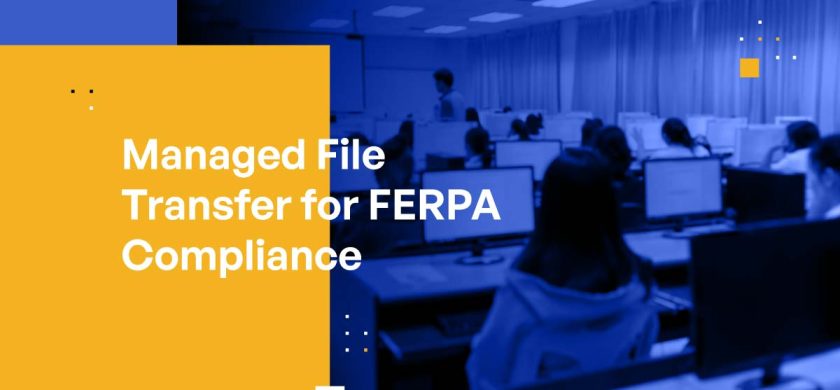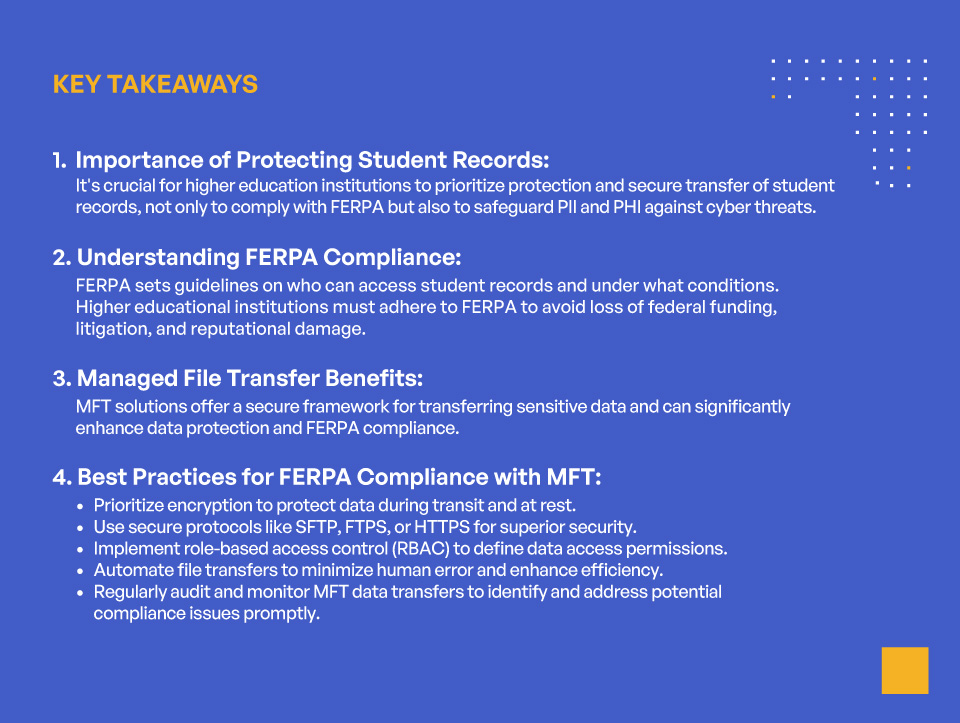
Managed File Transfer for FERPA Compliance
In the never–ending journey to become more efficient, cost–effective, and competitive, colleges and universities institutions are increasingly embracing and adopting technology solutions that process, store, share, and transfer student records. These higher education institutions are therefore producing and managing vast amounts of student data. These records do not just include grades and transcripts but also contain sensitive information that can be classified as personally identifiable and protected health information (PII/PHI).
Sharing such data with trusted third parties is a routine affair for higher education institutions, making it imperative to adhere strictly to the Family Educational Rights and Privacy Act (FERPA), which mandates the protection and secure transfer of these records.
In this post, we’ll explore the unique requirements involved in protecting student records when exchanged with trusted third parties in the context of FERPA, and explore best practices in using managed file transfer (MFT) technology to secure student records, protect student privacy, and ensure compliance with FERPA requirements.
Still debating between FTP and managed file transfer? Here are six reasons why managed file transfer is better than FTP.
Understanding Student Records
Student records, in essence, are a comprehensive documentation of a student’s journey throughout their academic tenure. These records commonly contain basic personal information like name, address and social security number, but also academic history, attendance, disciplinary records, financial aid details, health records and much more. This treasure trove of information is frequently targeted by cyber criminals who hack into the systems that process, store, share, and transfer these records. Hackers then hold the data for ransom or sell it on the dark web so it can be used for identity theft.
Transferring these records securely is a regular activity for higher education institutions. These are just a few use cases involving the transfer of student records to trusted third parties:
- Educational accreditation bodies: higher educational institutions often share their student records with these accreditation organizations to review and verify the academic standards and quality of the institution, which includes looking at student success rates, graduation rates, academic progress, etc.
- Other institutions: when a student transfers to another university or college, the original institution sends the student’s academic records to the new institution. This helps the new institution assess what level the student should be placed at and what academic credits they can transfer.
- Research partners: universities and colleges often participate in academic research in collaboration with other institutions or private companies. In such cases, anonymized student data may be shared for the purpose of research and analysis.
- Scholarship committees: if a student applies for a scholarship, universities may share the student’s academic records with the scholarship committee. It helps committees make decisions regarding the student’s eligibility and suitability for the scholarship.
- Student loan providers: Some institutions may share student records with student loan providers or government bodies handling student aid. This is to confirm the student’s status and verify their eligibility for financial support. All personal information is handled in regulatory compliance with privacy laws and regulations.
Each case emphasizes the importance of ensuring the security and privacy of these records, especially due to the sensitive nature of the data involved.
FERPA and the Need for Protecting Student Records
The Family Educational Rights and Privacy Act (FERPA), is a federal law in the United States that provides students with certain rights concerning their education records. At its core, the legislation aims to protect the privacy of student education records.
KEY TAKEAWAYS

KEY TAKEAWAYS
- Importance of Protecting Student Records:
It’s crucial for higher education institutions to prioritize protection and secure transfer of student records, not only to comply with FERPA but also to safeguard Pll and PHI against cyber threats. - Understanding FERPA Compliance:
FERPA sets guidelines on who can access student records and under what conditions. Higher educational institutions must adhere to FERPA to avoid loss of federal funding, litigation, and reputational damage. - Managed File Transfer Benefits:
MFT solutions offer a secure framework for transferring sensitive data and can significantly enhance data protection and FERPA compliance. - Best Practices for FERPA Compliance with MFT:
• Prioritize encryption to protect data during transit and at rest.
• Use secure protocols like SFTP, FTPS, or HTTPS for superior security.
• Implement role-based access control (RBAC) to define data access permissions.
• Automate file transfers to minimize human error and enhance efficiency.
• Regularly audit and monitor MFT data transfers to identify and address potential compliance issues promptly.
FERPA provides guidelines on who can access these records and under what conditions. For instance, without explicit consent, educational institutions cannot disclose student records. The only exception to this rule is when such information is shared with parties who have a legitimate educational interest or other FERPA exceptions. This means, ensuring FERPA compliance while transferring files isn’t a choice but a legal requirement.
Costs of Non–compliance with FERPA
Non–compliance with FERPA can result in serious consequences for educational institutions. The financial penalties can be severe, including loss of federal funding. Moreover, legal consequences awaiting violators include lawsuits from students or parents, possibly leading to expensive settlements. Lastly, institutions caught violating FERPA face reputational damage. The loss of trust can lead to decreased enrollment, causing further financial harm.
Managed File Transfer for FERPA Compliance
Managed File Transfer (MFT) solutions refer to a type of software used to manage the secure transfer of data from one computer to another through a network. MFT offers a higher level of control and security than standard FTP, making it a viable choice for ensuring the secure transfer of sensitive student records.
Although MFT solutions offer a robust framework to ensure secure data transfer, higher education institutions must adhere to certain best practices to fully realize the potential of these solutions in the context of FERPA compliance. We will discuss some of these practices below.
Best Practices for Using MFT for FERPA Compliance
Implementing a managed file transfer system to ensure the secure transfer of student records is not limited to the mere installation of the software. Higher education institutions should adopt best practices to leverage the full potential of MFT solutions and ensure optimal FERPA compliance. Here are some of the best practices:
1. Prioritize encryption: One of the key elements of ensuring secure data transfer is encryption. When using MFT solutions, ensure the software offers robust, end-to-end encryption to protect the data during transit and at rest. This prevents unauthorized access during file transmission, offering ultimate protection for student records.
Read more about encryption best practices.
2. Use secure protocols: Secure protocols like SFTP, FTPS, or HTTPS should be used when transferring student records. These protocols offer superior security features compared to standard FTP, thereby better complying with FERPA regulations. These protocols aid in secure data transfer, offering encryption, authentication, and integrity checks. Secure transmission and access control significantly reduce unauthorized access to student records.
3. Implement role–based access control (RBAC): RBAC allows institutions to define who can access and manipulate specific data. This minimizes the risk of unauthorized data usage or breaches, thereby strengthening FERPA compliance. RBAC assigns permissions based on roles rather than individuals, ensuring only authorized personnel access data.
4. Automate file transfers: Manual file transfers increase the risk of human error, leading to potential data breaches. MFT solutions often come with automated file transfer capabilities, mitigating this risk. Automated file transfers have an additional benefit in that they enhance employee efficiency and productivity. Employees can schedule a file transfer and move onto other projects.
5. Regularly audit and monitor MFT data transfers: Regular audits and real–time monitoring can help institutions spot potential data breaches or compliance issues early on. Most MFT solutions offer auditing and reporting tools to make this process easier. The auditing and reporting feature found in many managed file transfers solutions facilitates easy monitoring of data access, supporting swift identification of potential FERPA violations.
Kiteworks Helps Higher Education Institutions Protect Student Privacy With Secure Managed File Transfer
The task of transferring student records securely is a critical responsibility for all higher education institutions. The sensitive nature of these records makes their protection vital. To this end, FERPA provides the legal structure to ensure that student data is handled with the utmost privacy and security.
Managed File Transfer solutions offer an effective way to achieve FERPA compliance. By adopting the best practices mentioned above, institutions can ensure that their MFT systems are optimized for maximum security during file transfers, thereby protecting the valuable and sensitive data they contain. However, these practices are not a one–time implementation but rather a continuous effort in maintaining the highest level of data security in higher education.
The Kiteworks Private Content Network, a FIPS 140-2 Level validated secure file sharing and file transfer platform, consolidates email, file sharing, web forms, SFTP and managed file transfer, so organizations control, protect, and track every file as it enters and exits the organization.
Kiteworks secure managed file transfer provides robust automation, reliable, scalable operations management, and simple, code-free forms and visual editing. It is designed with a focus on security, visibility, and compliance. In fact, Kiteworks handles all the logging, governance, and security requirements with centralized policy administration while a hardened virtual appliance protects data and metadata from malicious insiders and advanced persistent threats. As a result, businesses can transfer files securely while maintaining compliance with relevant regulations
Kiteworks secure managed file transfer supports flexible flows to transfer files between various types of data sources and destinations over a variety of protocols. In addition, the solution provides an array of authoring and management functions, including an Operations Web Console, drag-and-drop flow authoring, declarative custom operators, and the ability to run on schedule, event, file detection, or manually.
Finally, the Kiteworks Secure Managed File Transfer Client provides access to commonly-used repositories such as Kiteworks folders, SFTP Servers, FTPS, CIFS File Shares, OneDrive for Business, SharePoint Online, Box, Dropbox, and others.
In total, Kiteworks secure managed file transfer provides complete visibility, compliance, and control over IP, PII, PHI, and other sensitive content, utilizing state-of-the-art encryption, built-in audit trails, compliance reporting, and role-based policies.
To learn more about Kiteworks Secure Managed File Transfer and its security, compliance, and automation capabilities, schedule a custom demo today.
Additional Resources
- Blog Post 6 Reasons Why Managed File Transfer is Better than FTP
- Blog Post Secure Managed File Transfer: Which Solution is Best for Your Business?
- Video Kiteworks Secure Managed File Transfer: The Most Secure and Advanced Managed File Transfer Solution
- Blog Post Navigate Complex Financial Regulations With Secure Managed File Transfer
- Blog Post Eleven Requirements for Secure Managed File Transfer